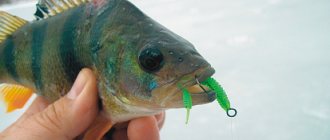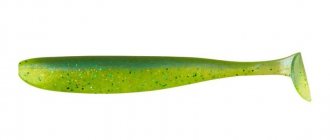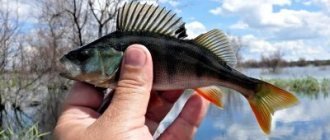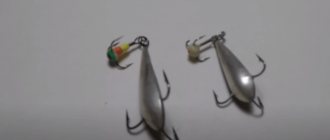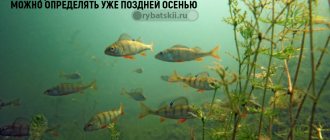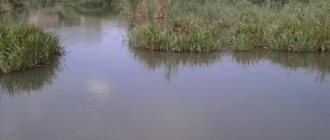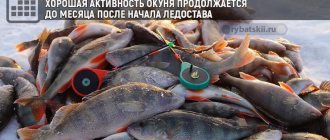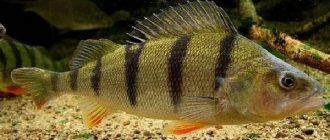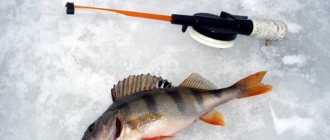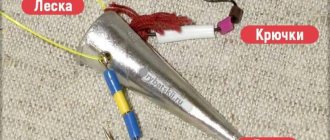To catch perch from the ice, jigs with bait and reelless jigs, spoons and a balancer are usually used. But you shouldn’t limit yourself to only them.
There are also more original options that you need to pay attention to. These include silicone baits made from regular or edible rubber.
They can produce very good catches, so they are definitely worth adding to your arsenal. Instead of bloodworms, maggots and other natural baits on the hook of a jig or spinner, you can use their artificial analogues.
And on reservoirs that are not covered with ice, catching perch with a spinning rod on a jig with rubber will bring good results.
Tackle for catching perch in winter using silicone from ice
For catching perch from ice using silicone, ordinary winter gear is suitable.
You can also use light jig fishing rods - a balalaika, a jig fishing rod with an open reel and other design options.
They are well suited for winter fishing with small silicone baits and light weights.
If you plan to catch medium and trophy perch, it is better to use gear that is used for fishing with light spoons and balancers.
Such a fishing rod usually consists of a fishing rod about 20-40 cm long , equipped with a plastic inertial reel. Both metal inertia and non-inertia motors are suitable, but there is no particular need to use them.
The best fishing line option is monofilament. The diameter is selected according to the size of the perch, usually monofilament with a thickness of about 0.12-0.15 mm is used.
Might be interesting:
- Catching perch in winter with rattlins
- Catching perch with fry and live bait in winter
Equipment for winter fishing with rubber
There are 4 main equipment options for catching perch using regular silicone or edible rubber from ice in winter:
- Mounting with jig head. A jig head is attached to the end of the main line (or a leash made of a thinner thread), onto which the bait is attached. It is better to mount it through a carabiner or a winding ring, in which case it will be easy to remove and replace with another.
- Installation with Cheburashka. This equipment is similar to the previous one, but at the end of the fishing line there is an eared sinker, to which a hook is mounted through one or two winding rings.
- Drop shot. There is a sinker at the end of the main line, and the hook is tied directly to it above it. This is one of the best rigs for vertical rubber fishing, which is used for fishing in open water from boats, bridges and other structures or from high banks.
- Sliding hook rig. Similar to a drop shot, but the difference is that the hook is not tied to the main line, but slides freely up and down along it. The advantage of this installation is that the bait gets more freedom.
Attention! To catch perch on silicone in the winter in a plumb line, it is better to use double hooks. They are the best at spotting fish. But you can also use regular single or offset printers.
How to catch perch using edible rubber
Edible rubber is considered one of the bait options that can save unsuccessful fishing if a passive perch refuses to attack other equipment. Of course, it is better to choose a time when a good perch bite is expected. An example of such conditions are warm spring days after the water has warmed up, or cloudy summer and autumn weather, when a striped predator comes out to feed in coastal waters, however, even in the case of unfavorable fishing weather, catching perch with edible rubber can be quite effective.
It would be preferable to choose fairly slow retrieves, while the animation can be either passive in nature, for example, dragging along the bottom, or active, accompanied by active twitching of the tip of the spinning rod. The main condition is that the bait should not leave the fish’s visibility zone too quickly so that the latter has time to smell it.
To load the bait, a classic jig head is usually used, but spaced equipment, such as a retractable leader, can also be used. The weight of the load is selected based on the conditions of the reservoir and the strength of the current. For catching perch, a regular single hook is more often used, since the soft mouth of the perch is perfectly caught with one sting, while the number of hooks with it is noticeably reduced.
Selection of baits for ice fishing
Of the wide variety of silicone baits for catching perch in winter, you can use almost any one. Most often used:
- twisters;
- vibrotails;
- crustaceans;
- various fancy baits.
Reference. Some silicone baits freeze at sub-zero temperatures and become unusable.
On sale you can find special winter tires, edible or without flavors. But regular summer silicone baits will also work. You just have to experimentally select which rubber manufacturers retain their performance properties in the cold.
It is better to use edible rubber for catching perch in winter. The aroma and taste of such baits attract passive fish much better. But ordinary inedible silicone baits also bring good catches.
Ice fishing technique
The wiring used is the same as when fishing with other baits:
- oscillations - in one place or with a rise, as when fishing with a jig;
- smooth lifting and lowering of equipment;
- throws to a height of about 20-30 cm and sharp drops, as when fishing with a spoon;
- tapping on the bottom.
The optimal wiring when catching perch in winter with rubber from ice must be selected experimentally for a specific bait and the mood of the fish. Small silicones should be used more like jigs, and large ones - like spinners.
Silicone micro baits
There is also an interesting option for silicone for catching perch in winter, such as microbaits. It can be:
- artificial bloodworm;
- maggot;
- worm;
- eggs and so on.
They can be used as a bait on the hook of a jig, spinner or balancer instead of natural bait. Another option is to tie one or more leashes with hooks above the main bait, which is located at the end of the fishing line, and attach rubber to them.
The advantage of silicone baits is that they are much less hassle than natural baits. If you use such micro-baits made of edible rubber, they will attract perch not only with their appearance, but also with their smell and taste - just like real bloodworms or maggots.
But regular silicone, without adding flavorings, also brings good results. Sight plays an important role in perch hunting, and the attractive appearance of the bait is enough for him to rush into the attack.
Artificial silicone microbaits for catching perch can be easily cut by yourself. For example, vibrating tails or twisters damaged by pike teeth are suitable for this purpose.
Hogy Hog
Lures from the well-known company Lucky John made of edible rubber and strange at first glance are already often used in open water, and now on ice. One of the most famous baits is Hogy Hog . Their positive feature is the ability to arouse the interest of the perch during a bad bite, when the predator refuses traditional spinners and reelless baits, and only small “sailor fish” bite on a jig with a bloodworm. Hogs Hogs made of edible rubber in such situations are both bait and a fairly large bait that very small perches do not dare to attack. The perch is especially excited by the many active elements of the bait that move under the pressure of water, which, along with the smell of food, doubles its activity.
bait has a persistent odor , which is not lost in the water as quickly as dips and flavors. This is due to the fact that edible silicone, which smells of crayfish, shrimp and other similar living creatures, is 60% of the material from which the bait is made, and the coating of aromatic oil serves only for the initial effect, to attract fish to the hole. Then the odorous structure of the Hogy Hog bait material itself is included in the process, which attracts the predator with its smell until the very end of fishing and can still serve on the next fishing trip.
Gear selection
For such fishing, regular “summer” gear is suitable. But increased demands are placed on the quality of spinning rods. This applies primarily to the coil. Even those inexpensive, inertia-free fishing gear that allow you to fish properly in warm weather can begin to fail at subzero temperatures. If the original reel lubricant freezes in winter, it will have to be replaced with one suitable for fishing in cold weather.
fishing line
braided line is best suited . Due to its low elongation, it will provide the gear with maximum sensitivity. This is an important point in bottom fishing. The disadvantage of braid is that at temperatures below zero it freezes. To avoid this, it must be impregnated with antifreeze. Vaseline oil, which can be bought at any pharmacy, is suitable.
You can also use monofilament . It is well suited for fishing at short distances. Monoline does not freeze at subzero temperatures.
Snaps
The following equipment is used for catching perch in winter using rubber and spinning rods:
- jig rigs with jig heads and Cheburashka sinkers - standard basic equipment;
- drop-shot and retractable leash - for hunting passive perch;
- Texas and Carolina rigs are a good choice for fishing deep snags, where trophy bass often hold at any time of the year.
Learn more about rigs for catching perch in winter from ice to silicone in this video:
Lures
As with ice fishing, you can use any kind of bait. Preference should also be given to edible rubber. The size of baits for fishing in winter should be smaller than in warm water - about one and a half times.
Popular baits for perch made of edible silicone
Today, Japanese manufacturers occupy key positions in the ranking of edible silicone. As a rule, products from famous brands are in a high price range, so not every spinner can afford them. The demand for soft baits has given manufacturers from the CIS countries an opportunity to enter the market. As a rule, they do not have original forms of nozzles, but in the lines you can find analogues of Japanese rubber.
Popular forms of bait:
1. Tanta. This artificial bait has won the hearts of perch fishermen with its natural action. There are many ribs along the body of the bait, which are responsible for the mobility of the model. When animated, Tanta resembles a small leech.
2. Sexy Impact. One of the most popular slugs has a characteristic feature - thinning in the middle of the body. There are two ways to attach a leech to a hook: along the back and from the side. Sexy Impact is also perfect for mounting “veki” and any spaced equipment.
3. Fishtail. Combining a leech with a fry led to the appearance of this bait. The elongated body in combination with a fish tail was so loved by the perch that they decided to enlarge the artificial bait and test it on pike perch.
4. Aji Ringer. Perhaps this is one of the most mobile models among passive rubber. The multi-stage tail with three membranes plays inimitably in the current, although the bait also works in still water. The Aji Ringer is a universal attachment that works with a variety of wires. In late autumn, she shows herself on smooth pulls and throws, and in the spring – on high-frequency dribbling.
5. Larva. This model appeared not so long ago, but in a matter of months it firmly entered the lines of many brands from other countries. The dragonfly larva was tested not only on European perch, but also on underwater inhabitants around the world.
These models, present in the fisherman’s box, will help you get away from zero even in the most difficult conditions. Each form of edible rubber, like a wobbler, has different types of animation when using one or another wiring. Before fishing, it is advisable to “drive” the silicone in shallow water, where you can monitor its play.
Passive rubber also differs in material structure
Softer silicone is better accepted by fish, but its service life is much shorter. High-quality products are impregnated with attractants and may contain salt. Many anglers mistakenly believe that salt affects the taste of the bait, but, as a rule, its purpose is to impart buoyancy to soft material. The fact is that it is easier for perch or any other predator to pick up a vertically located bait from the bottom than silicone lying on the bottom.
Color also plays an important role in choosing a model.
In clear water, products in natural shades have proven themselves to be the best. Adding shine is an important aspect of catch rubber. Such a minor detail imitates scales and gives reflections in different directions, thanks to which the perch sees the bait from afar. Bright colors are used during the flowering period. Also, a provoking bait is considered one of the best search engines. When the school is localized, the spinner switches to the usual models in dark colors and catches passive fish.
Features of fishing techniques
The fishing technique is the same as in spring, summer or autumn. But the wiring should be slow and smooth. This game is the best way to entice perch, which is passive in cold water, to bite. When retrieving in steps, it is necessary to reduce the number of reel revolutions per step, slow down the reeling rate and increase the pause. When fishing with a lead or drop shot, you can play with the bait for a long time at one promising point or slowly drag the sinker along the bottom.
Silicone lures are very effective in catching perch from the ice. Few people know that they can be used for this kind of fishing, but they are worth paying attention to. By adding such baits to your collection, you will significantly increase your catches. If you have the opportunity to fish on an ice-free body of water in winter, it’s never too late to try winter spinning. And rubber in such a situation will be the best bait option for hunting perch and other predators.
Unloaded rubber - both pike and perch.
Catching pike with unweighted silicone baits.
Unloaded rubber - this is the phrase I uttered most often in the last spinning season, this phrase was most often found in my fishing reports for 2014, this is the name that you, my dear spinners, need to remember once and for all.
Simple and affordable equipment will forever change your ideas about how and what to catch pike with. Unloaded tires became a real discovery of the 2014 season for me, so there is so much delight and admiration!
Today almost everyone is caught using wobblers and jigs. Many spinning players prefer leash rigs; some are not going to give up spinners and spinners. Among the huge number of baits and equipment, unloaded rubber is not mentioned as often as it deserves.
In order not to be unfounded, I’ll start right away with a short video about spring fishing, where for the first time I was able to appreciate the stunning advantages of unloaded tires.
That's it, gentlemen, spinners - simple and effective.
Let me make it clear right away that this article will only talk about those installation methods and those silicone baits that I have personally used and in which I am completely confident. What, how and why - I’ll tell you about this in the next article, so as not to lump everything into a heap.
Rubber.
In my case, these are Lucky John Mister Greedy in sizes 99 mm (3.9″) and 76 mm (3″), as well as Lucky John Long John 79 mm (3.1″). Long John has one pike and only a couple of fishing trips to his name.
Therefore, we remember - Lucky John Mister Greedy! We won't need the rest for now.
What is so good about this edible rubber? As a rule, all edible rubber is stuffed, in addition to secret molecular compounds that attract fish stock, with “top-secret” salt. Particularly due to salt, edible silicone baits often end up sinking, slowly sinking.
Using the example of Lucky John Mister Greedy, we can say that its immersion speed is optimally ideal, in simple terms – “as it should be.” Mr. Greedy also has a very good shape. The weight and shape of the bait ensure that it is cast far and does not deviate much from the casting direction (in the absence of a strong side wind), that is, the cast is quite accurate. Almost a “perfect” bait for unloaded equipment. Let's stop there for now.
Installation.
With Lucky John Mister Greedy 99 mm (3.9″) I used offset presses No. 4/0, 5/0, and with 76 mm (3″) Mister Greedy I used offset presses No. 1/0, 2/0. Installation could not be simpler - a vibrating tail with an offset hook. For those who are not yet familiar with the method of attaching silicone baits to an offset hook, detailed photo instructions for this simple action are provided below.
Installation of unloaded rubber
1. Select an offset hook according to the size of the bait. In this case, the Kosadaka offset hook No. 5/0, in my opinion, is quite suitable.
2. We pierce the vibrating tail with an offset hook.
3. Move the bait onto the offset ledge. And we notice the puncture site.
4. We pierce the bait with the tip of an offset hook in the intended place.
5. Carefully remove the tip of the offset hook so that it ends up in a special groove.
6. Bait attached to an offset hook. The hook tip is in a special groove.
7. Equipment “unloaded rubber” in a non-snacking design.
That's it, gentlemen, spinners! Ready! You can catch it. And how to catch! Look.
Wiring.
Unloaded rubber, be it Mr. Greedy, or any other bait, does not require any specific wiring. Short, gentle jerks, jerks that are a little stronger and sharper, that is, twitching of the bait of varying frequency, amplitude and strength. What does it remind you of? That's right, twitching, in the sense of twitching.
Mr. Greedy responds with pleasure to such manipulations, but not nervously and fussily, like some wobblers, but with a leisurely, slow-motion grace. Bites, as a rule, occur during a pause, often a very long pause, when the rubber slowly, slowly sinks to the bottom. A grip at the moment of falling of unloaded rubber, “for a splash,” also happens.
In addition, Lucky John Mister Greedy (vibrating tail) can be carried out evenly or generally used for demolition.
The impression is created that it is enough to attract the pike with several active movements of the bait, and then the unloaded rubber will do everything itself. Yes, wiring can be done in any direction: downstream, upstream, across the stream.
It is worth noting this point: perch also readily bite on Lucky John Mister Greedy edible rubber measuring 3″, that is, in our opinion, 76 mm. The perch, I’ll tell you, is larger than usual, about the size of your palm. Therefore, in order to increase the likelihood of catching fish, you can safely use edible rubber of just this medium size. At the same time, the chances of catching increase significantly.
The 3.9″ (99mm) Lucky John Mister Greedy is an almost exclusively pike option. What is also important is that to date, no bites of pike weighing less than 500 g on a bait of this size have been observed.
That's all. Everything is so simple that it is understandable and accessible even to beginning spinners.
In conclusion of the article, I will try to dwell in more detail on the advantages and disadvantages of unloaded tires.
Advantages.
1. Efficiency. You can catch fish with unloaded rubber, sometimes very well.
2. Patency. The bait is mounted in a non-clinging version, so it is not afraid of obstacles above and below water: aquatic plants, branches, tree trunks and other piles. Unloaded tires easily overcome all this “junk”.
3. Easy to install. To learn how to attach, in this case, a Lucky John Mister Greedy vibrating tail, to an offset hook, just try it once, looking at the photographs in the article.
4. Easy wiring. Wiring does not cause any difficulties even for inexperienced or novice spinning anglers.
5. Versatility. Unloaded tires, practically all-season equipment
Flaws.
1. Fragility. Rubber, unfortunately, and especially edible rubber, does not live long on a hook. Even if you didn’t get a single bite, and the rubber was not damaged by the teeth of a predator, it is gradually “broken” by the offset hook to such an extent that it becomes impossible to continue fishing.
Grand total.
Fellow hobbyists, forgive my importunity, but I strongly recommend trying such effective equipment as unloaded tires. Feel free to experiment with any silicone baits that you think may be suitable for such installation, without waiting for my articles.
And if you suddenly don’t catch anything, then only you will have yourself to blame! (joke)
Vlad IONOV (photo Vlad IONOV, video Vlad IONOV).
